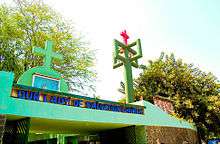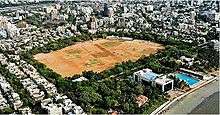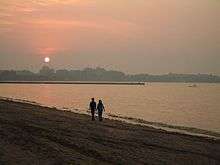Dadar
| Dadar | |
|---|---|
| Neighbourhood | |
 Kabootar Khana, Dadar (West) | |
 Dadar | |
| Coordinates: 19°01′16″N 72°50′28″E / 19.021°N 72.841°ECoordinates: 19°01′16″N 72°50′28″E / 19.021°N 72.841°E | |
| Country | India |
| State | Maharashtra |
| District | Mumbai City |
| City | Mumbai |
| Languages | |
| • Official | Marathi |
| • Native | Konkani |
| Languages | |
| Time zone | UTC+5:30 (IST) |
| PIN | 400014, 400 025,400028[1] |
| Area code(s) | 022 |
| Civic agency | BMC |
| Lok Sabha constituency | Mumbai South Central |
| Vidhan Sabha constituency |
Mahim (covers western part of the suburb) Wadala (covers eastern part of the suburb) |
Dadar is the first planned suburb of Mumbai.It is a densely populated residential and shopping neighbourhood.It is also a prominent railway and bus service hub with local and national connectivity.[2] Dadar is also a hub for the immigrant Marathi culture, which gradually replaced the native East Indian one, in Mumbai.
History
Etymology
Dadar (दादर) in Marathi language means 'Ladder', perhaps indicative of its importance as an important connection between main Mumbai island and surrounding islands in the past.
Origins

In the 16th century, the area was known as lower Mahim as it was located on the island of Mahim, one of the Seven islands of Mumbai which, after the Bombay Island, was the most important during the whole of the Portuguese period.[3] The Portuguese Franciscans built a church here in 1596 called Nossa Senhora de Salvação, which is popularly known today as Portuguese Church and is a familiar Dadar landmark.[4]
19th and 20th century
The Dadar-Matunga-Wadala-Sion scheme of 1899-1900 was the first planned scheme in Mumbai. The Bombay Improvement Trust devised the plan to relieve congestion in the center of the town following the plague epidemics of the 1890s. According to the survey plan, 60,000 people were to be housed at Dadar-Matunga and an equal number in Sion-Matunga. 85,000 people were to be accommodated in the developments in Sewri-Wadala.
Among the institutions moved to Dadar under the City Improvement Trust (CIT)[5] plan were Victoria Jubilee Technical Institute, now known as Veermata Jijabai Technological Institute and King George school, now known as IES' Raja Shivaji Vidyalaya (now a collection of several schools). The plan regulated constructions and restricted building construction to three storeys high with open space between them.
Ramnarain Ruia College in 1937 and Ramniranjan Podar College was founded in 1939, completing Dadar’s transition from residential area to a diverse neighborhood. Both colleges are run by SP Mandali. Dr. Antonio Da Silva High School one of the oldest school founded in 1851 during the British India period is located here.
During the cotton mill era of Mumbai, some key mills like Bombay Dyeing (Spring Mills), Gold Mohur Mills, Kohinoor Mills, Ruby Mills and Tata Mills were located in Dadar. During the redevelopment of Mumbai mills some of these were redeveloped or went defunct.
By 1937 Shivaji Park and the surrounding areas were developed. This public space was to become an important stage in the political drama leading up to India's independence. Later political history in Mumbai also unfolded in this park.
The Sharadashram society as well as school built in 1948-50 are the biggest landmarks of Dadar. Sharadashram society is Asia's first registered society as well as first society in Mumbai.
In 1993 Bombay bombings, a defused bomb was discovered in Dadar by Dr. JK Mandot who also provided the Mumbai police their first clue in the 1993 blasts probe, when on 13 March 1993, he alerted them about a dubious-looking Bajaj Chetak scooter (MH-04-Z-261) parked outside his dispensary on Naigaum Cross Road. The scooter, laden with RDX, had failed to explode, and was defused after Mandot's call to the police control room[6]
Present
Dadar as a neighbourhood has undergone tremendous changes. Places like Parsi colony and Hindu colony still retain the old world charm but much has changed over the years - Iranian restaurants have vanished, old traditional buildings have been converted into modern apartments, chawls are difficult to find and existing ones are in dilapidated condition, well known eateries are giving way to new food joints and delicacies, and the history behind landmarks like Dadar T.T. have become obscure. Dadar has growing importance in the current scenario because of its railway routes as well as residence of many famous personalities related to the Marathi film industry.
Description
Park Chowpatty or sea shore Dadar West is widespread up to Reunion Restaurant where Mahim starts in north and up to Sayani Road Junction were Prabhadevi starts on south. Similarly Dadar East is widespread up to Five Gardens were Matunga starts in North and up to Premier Theatre in South were Parel starts.
Economy

Dadar West market is a very popular shopping destination for residents of central Mumbai, the suburbs, and distant satellite towns. Dadar vegetable market is the heart of the city and was responsible for distributing vegetables across all of Mumbai. It was once said that one can get all possible things in Dadar. Both east and west areas are dotted with women's (particularly spree) and children's clothing shops. Many prominent jewelry shops can be found in Dadar. Mumbai's first Titan watches showroom was opened in Dadar in 1989.
Infrastructure
Prominent Residential Neighbourhoods
- Shivaji Park
- Veer Savarkar Smarak
- Worli - Bandra Sea link view
- Mayoral Bungalow
- Dr.B.R.Ambedkar Memorial (Chaitya bhoomi)
- Balmohan Vidya Mandir
- Sane Guruji Vidyalay
- Dr. Antonio Da'silva High School
- IES King George School
- Institute of Hotel Mgmt., Catering Technology & Applied Nutrition
- Kohinoor Catering College
- Kokane's Kohinoor Technical Institute
- Government Industrial Training Institute (for Women)
- Swami Samarth Math
- Hindu colony
- Lokmanya Tilak Colony
- Khandke Building, (1-12)
- Dadar Parsi Colony
- Plaza Cinema Hall
- Swatantraveer Savarkar Market
- Kabutar Khana
- Portuguese Church
- Rajgad (MNS Headquarters)
- Sena Bhavan (Shivsena Headquarters)
- Tilak Bhuvan (Congress Headquarters)
- Shivaji Natya Mandir
- Prakash Hotel
- Shardashram Vidya Mandir
- Saitan Chowki Naka
- Gurdwara Sri Guru Singh Sabha
- Goregaonkar Premises - Dadar's 2nd oldest Ganeshotsav (Since 1921)
- Khed Gully Dadar
- Siddhivinayak Temple
- Ravindra Natya Mandir
- Kirti College
- Datta Raul Maidan
Dadar is also home to the Mumbai Mayor's Bungalow, the official residence of the Mayor of Mumbai.
Transportation
Rail Transport

Dadar is a prominent railway terminus on both the Western and Central lines of the Mumbai Suburban Railway network. Being the only common railway station to both the Central and Western lines, it makes a transit point for many passengers traveling through Suburban Railway. It is estimated that the station receives more than 500,000 visitors daily.
Road Transport
Dadar east has been also a key interchange point for those coming from Pune, Panvel and Navi Mumbai by road transport. A bus hub next to Dadar GPO is a destination point for many buses coming from out of Mumbai.
Locally, Dadar is well connected to other neighbourhoods of Mumbai, namely Matunga, Wadala, Parel, Elphinstone Road, Prabhadevi, and Mahim.
Culture
Dadar has long been a cultural center for the native East Indians and the Marathi speaking immigrants from the rest of Maharashtra. Being along the Konkan coast, like the rest of Mumbai, the native language of the region was a dialect of Konkani.
Cinema
Dada Saheb Phalke (in recognition of whom the road Dada Saheb Phalke Road is named) partly shot his first film "Raja Harishchandra" at Mathura Bhavan, in one of his friend's residence in Dadar East.[7] Apart from this studio, many other prominent film studios such as Ranjit Studios and Rooptara Studios were eventually built on this road.
There is also an active crowd that watches dramas and Shivaji Mandir is one of the few theatres in Mumbai that has catered to the middle class' interest in the dramatic arts. It was here that artists like Vijay Tendulkar, Vijaya Mehta, Mahesh Elkunchwar, Dr. Shreeram Lagoo and Nana Patekar found an eager audience.
Dadar has been also home to movie halls like Chitra Cinema, Inox Nakshatra and Hindmata Cinema. Plaza Cinema, a prominent theatre in west Dadar was damaged during the 1993 bomb-blasts/riots. It has now reopened and remains one of the theatres in Mumbai that show Marathi movies.
Restaurants and cuisine
Vada Pao was invented outside Dadar Station in 1971, by Ashok Vaidya using the Pao (Portuguese word for bread).[8] Apart from Vada Pao, Dadar is also popular for traditional Maharashtrian food like Batata Vada, Thalipith, Sabudana Vada, Misal Pav, Usal Pav, Puri Bhaji, Pithla Bhakri, Piyush (a sweet drink) and Lassi. There are many restaurants likePrakash Hotel, Aaswad Hotel, Sindhudurg Hotel, Gomantak Hotel and Panshikar that serve Marathi food. However, food option is as diverse as it can get in Mumbai. Restaurants catering to Udupi, Panjabi and north Indian, Chinese, Thai and many other cuisines dot the landscape.
Park & Gardens

Shivaji Park, one of the largest parks in Mumbai is situated in Dadar west and is the hub of sports activities, particularly for cricket enthusiasts. Many cricketers like Ashok Mankad, Vinoo Mankad, Vijay Hazare, Salim Durani, Ajit Wadekar, Sunil Gavaskar, Sandip Patil, Sachin Tendulkar, Vinod Kambli, Ajit Agarkar and Sanjay Manjrekar have been trained here. Spread across 112, 937 square meters (27.907 acres) it houses Samartha Vyayam Mandir (gymnasium), Shivaji Park Nagrik Sangh, Shivaji Park Gymkhana (club), children's park, Nana Nani park, Scout's Pavilion, Ganesh Mandir, The Bengali Club with Kali shrine and a library. The walkway is lined with huge rain trees and stone wall for sitting, a popular evening spot for many residents around.

Dadar Chowpatty (seashore) with its sea, sand and Mumbai chat counters is a popular gateway for families from the hustle bustle of the city. Some other parks include Five Gardens next to Parsi Colony, Veer Kotwal Udyan, Vaidya Udyan along Lakhamsi Nappu road.
Places of worship
Dadar has plenty of religious places including BAPS Swaminarayan Mandir (opp. Dadar east railway station), Rustom Foramina Agiary (Parsi colony), N C Narielwala Dadar Agiary (Naigam cross road), Kali Temple (Shivaji Park), Ganesh temple (Shivaji Park), Siddhivinayak Temple (Dadar), Jakhadevi Mandhir (Saitan Chowki) Sri Guru Singh Sabha Bombay (Ambedkar road), Shri Krishna Mandir Sabhagruh, Shri Mahaveer Digambar Jain Mandir, Hanuman Mandir (outside Dadar east railway station), Peer Bagdadi Dargah and mosque, Portuguese church (Dadar west), St. Marys Orthodox Cathedral (first Malankara Orthodox Syrian church in Mumbai) and Indian Pentecostal church.
Dadar is also home to Chaitya Bhoomi, memorial and place where Dr. Babasaheb Ambedkar, Chief architect of Indian Constitution was cremated. His death anniversary, 6 December, is observed as Mahaparinirvan Din when lakhs of people across the nation throng Chaityabhoomi to pay homage to him.
Education
Dadar boasts some of the most reputed schools and colleges in Mumbai. Antonio Da Silva High School (estd 1868), King George School (now IES) (estd 1912), Shardashram Vidya Mandhir School and Balmohan Vidyamandir (estd 1940) are some of the oldest schools founded during the British India period. Dadar East houses Smt. Kamla Mehta Dadar School for the Blind, a 100+ year old institution that was set up by American Marathi Mission to serve blind children.[9]
Two of the most prominent colleges in Mumbai, Ramnarain Ruia College and Ramniranjan Anandilal Podar College of Commerce and Economics are near Dadar.[10] Veermata Jijabai Technological Institute is one of the oldest engineering colleges in India and is in Matunga, adjacent to Dadar.[11]
Dadar hosts specialised institutes like Institute of Hotel Management (IHM) and National Institute of Fashion Technology or NIFT (Ministry of Textiles, Government of India).
Famous personalities
List of prominent personalities who resided in Dadar include:
- Vinayak Damodar Savarkar in Savarkar Sadan, Shivaji Park
- B. R. Ambedkar in Rajgruha, Hindu colony
- Bal Thackeray
- Meena Kumari
- Sandeep Patil
- Ajit Agarkar
- Boman Irani
- Raj Thackeray
- Prakash Ambedkar
- Nana Patekar
- Sachin Tendulkar
- Sunil Gavaskar
- Milind Soman
- Atul Parchure
- Rahul Roy
- Renuka Shahane
- Durga Jasraj
- Sachit Patil
- Urmila Matondkar
- Vasant Desai
- Baban Prabhu
- Sudhir Phadke
- Vandana Gupte
- Premnath
- Neelam Prabhu
- Ajit Wadekar
- Vijay Aurora
- G. D. Madgulkar
- Yeshwant Deo
- Jitendra Abhisheki
- Prabodhankar Thackeray
- Gajanan Jahagirdar
- Shirish Kanekar
- Sulabha Deshpande
References
| Wikimedia Commons has media related to Dadar. |
- ↑ "Pincode Locator Tool". Pincode.org.in. Retrieved 11 January 2014.
- ↑ "Dadar, Mumbai's first planned suburb". scroll.in.
- ↑ "History of Portuguese Church". Salvacaochurch.tripod.com. Retrieved 29 March 2012.
- ↑ Archived 2008-09-14 at the Wayback Machine.
- ↑ "Dadar, Matunga, Wadala, Sion: Mumbai/Bombay pages". Theory.tifr.res.in. Retrieved 18 August 2017.
- ↑ "Doctor whose curiosity triggered a blast and saved lives - Indian Express". Archive.indianexpress.com. Retrieved 18 August 2017.
- ↑ "Where it all began". Thehindu.com. Retrieved 18 August 2017.
- ↑ "Nearly 50 years since its invention, the story of the vada pav hits the big screen at Jio MAMI". www.firstpost.com.
- ↑ "Archived copy". Archived from the original on 2016-06-23. Retrieved 2016-04-04.
- ↑ "R.A.Podar College Of Commerce & Economics Official Website". Rapodar.ac.in. Retrieved 2016-06-30.
- ↑ "A Brief History of VJTI". Vjti.ac.in. Retrieved 2016-06-30.